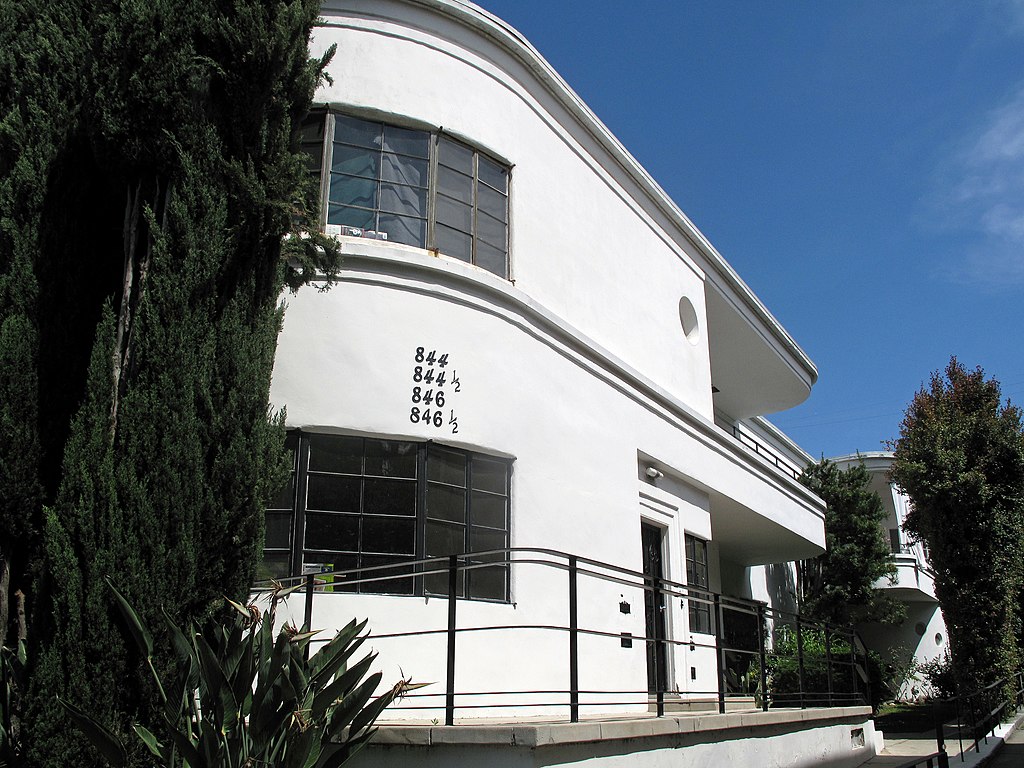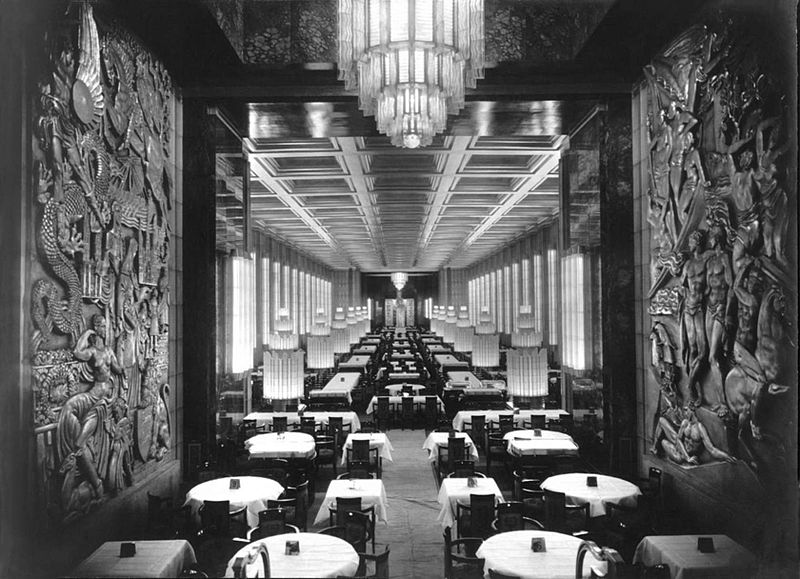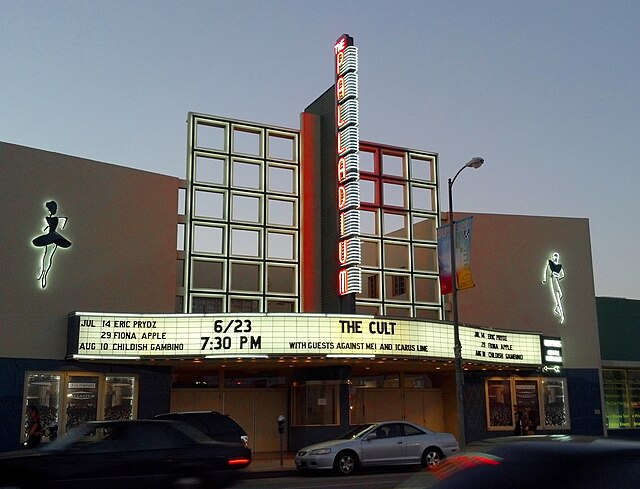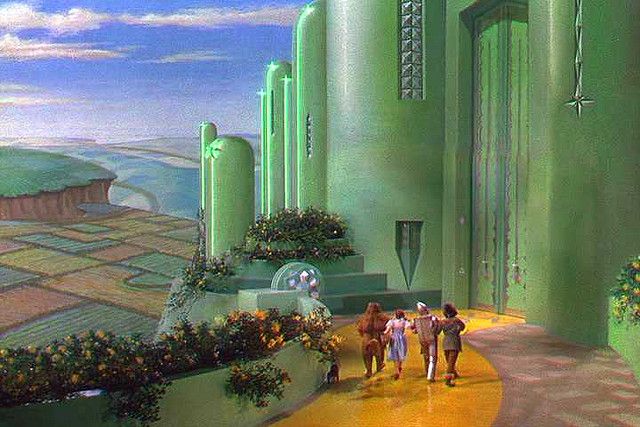
- calendar_month November 30, 2023
- folder Home Design & Decor
The speed of architecture may not be exactly white knuckle. Especially from our point of view in modern Los Angeles where construction for even a modest building can take ages. But an offshoot of Art Deco, Streamline Moderne, was all about architecture in motion. Streamline Moderne architecture pared down Art Deco’s decadence with a more efficient minimalism reflective of an era of economic hardship. Yet, it also emphasized boldly moving onward, in life just as much as industry. In this way, it presaged Googie architecture, though without the latter’s sense of whimsy. Rather, Streamline Moderne was a no-frills foray into the future that never forgot from whence it came.
The New Style on the Horizon
Photo credit: Downtowngal
As the Great Depression worsened into the 1930s, the grand flourishes of Art Deco became less and less practical. Yet, the Art Deco aesthetic hadn’t exactly overstayed its welcome in the public’s opinion. Thus, in the early ‘30s, designers began to experiment with a stripped down take on the established Art Deco compositions.
Art Deco’s challenging angles became less frequent, replaced by bold lines leading sensibly forward, forgoing its predecessor’s upward trajectory for horizon-chasing contours. The shift was pioneered primarily by industrialists who recognized the impractical frivolity of Art Deco’s ornamentation. Streamline Moderne was more conducive to their spirit; fast-track thinking with a tight focus on results. They knew exactly where they were headed and wanted to get there as soon as possible.
Paring Down with Streamline Moderne Architecture
The financially responsible take on Art Deco offered by Streamline Moderne may have been minimalistic, but it was still creative. A-frame roofs flattened out, sharp edges were rounded out, and a pronounced emphasis on aerodynamics became more and more evident.
Photo credit: Author Unknown (circa 1935)
Despite the economically crippling Great Depression, progress found a way. And this was artfully reflected in Streamline Moderne architecture. Perhaps the technological strides were most evident in the first incorporation of electrical light into architecture. In the early 1930s, a newly constructed French ocean liner, the SS Normandie, incorporated 38 electrically luminous columns installed across 12 glass pillars into its first-class dining area.
Another early example, the design of the Strand Palace Hotel’s foyer, made artful use of glass lit from within. It was such a striking example that the Victoria and Albert Museum saved it from demolition, retaining it for display at the museum. This made the foyer the first piece of Streamline Moderne interior design to be preserved by a museum.
Features of Streamline Moderne Architecture:
- Emphasis on horizontal orientation
- Visual representations of speed
- Aerodynamic contours
- Smooth, rounded curves
- Flat roofs
- Use of concrete, chrome, and glass materials including glass bricks
- Nautical themes including glass portholes
- Asymmetrical shapes
- Stripes to convey streamlined aesthetics
- White or muted pastel paint
- Prominence of electrical lighting
The Forward Motion of Streamline Moderne
Photo credit: Doug Goodwin
With our Los Angeles Architecture 101 series, we’re most concerned with how the Streamline Moderne style fits what was happening in LA in the 1930s. Here, it was mostly popularized by architects working on structures in industrial areas and ports. It makes sense that a style so concerned with motion would find utility in buildings devoted to transportation. Bus depots, train stations, and even dockside and airport terminals regularly employed Streamline Moderne designs.In fact, the nautical themes were so rampant in Streamline Moderne that the French dubbed it style paquebot meaning “ocean liner style.”
Streamline Moderne Goes Hollywood
That’s not to say this was a strictly industrial mode of architecture. Those familiar with Streamline Moderne can find its horizontal lines gracing multifamily apartments and bungalow courts as well as the occasional single family home.
And with Hollywood being Hollywood (or, in this case, Culver City) Streamline Moderne even found its way to the silver screen. This is perhaps most famously represented in MGM’s 1939 cinematic classic The Wizard of Oz. In the film, The Emerald City is a direct construct of Streamline Moderne architecture; all sleek curves, rounded edges, and sparse ornamentation.
Photo credits: MGM
Beyond Streamline Moderne’s Inertia
Streamline Moderne maintained its popularity throughout the 1940s. But in the ‘50s, it was overtaken largely by the rise of The International Style and Mid-Century Modern architectures. While the style would be revisited over the decades, it would be properly distinguished as Streamline Revival.
Fortunately, plenty of sterling examples of Streamline Moderne architecture remain around the city today.
Examples of Los Angeles Streamline Moderne Architecture
- Bullock’s Pasadena – 401 S. Lake Ave, Pasadena, CA 99101
- Burbank City Hall – 275 E Olive Ave, Burbank, CA 91502
- Chili John’s – 2018 W Burbank Blvd, Burbank, CA 91506
- Coca-Cola Building – 1200 – 1334 South Central Ave, Los Angeles, CA 90021
- El Rey Theatre – 5515 Wilshire Blvd, Los Angeles, CA 90036
- Fox Bruin Theater – 961 Broxton Ave, Los Angeles, CA 90024
- Gerry Building – 910 S Los Angeles St, Los Angeles, CA 90015
- Hollywood High School – 1521 N Highland Ave, Hollywood, CA 90028
- Hollywood Palladium – 6215 Sunset Blvd, Hollywood, CA 90028
- Jefferson High School – 1319 E 41st St, Los Angeles, CA 90011
- Mark Keppel High School – 501 E Hellman Ave, Alhambra, CA 91801
- Kirk Douglas Theatre – 9820 Washington Blvd, Culver City, CA 90232
- Lipetz House – 1843 N Dillon St, Los Angeles, CA 90026
- Long Beach Airport – 4100 Donald Douglas Dr, Long Beach, CA 90808
- Los Angeles Maritime Museum – 84 Foot of 6th St Berthing, San Pedro, CA 90731
- Lydecker House – 3820 Buena Park Dr, Studio City, CA 91604
- Pan-Pacific Auditorium – 7600 W Beverly Blvd, Los Angeles, CA 90036
- Royal Laundry Complex – 443 S. Raymond Ave, Pasadena, CA 91105
- Saban Building – 6067 Wilshire Blvd, Los Angeles, CA 90036
- Saks Fifth Avenue – 9600 Wilshire Blvd, Beverly Hills, CA 90212
- The Beacon Hotel – 1301 Ocean Ave, Santa Monica, CA 90401
- Union Station – 800 N Alameda St, Los Angeles, CA 90012
- United States Post Office, San Pedro – 839 S Beacon St, San Pedro, CA 90733
- Warner Grand Theatre – 478 W 6th St, Los Angeles, CA 90014




